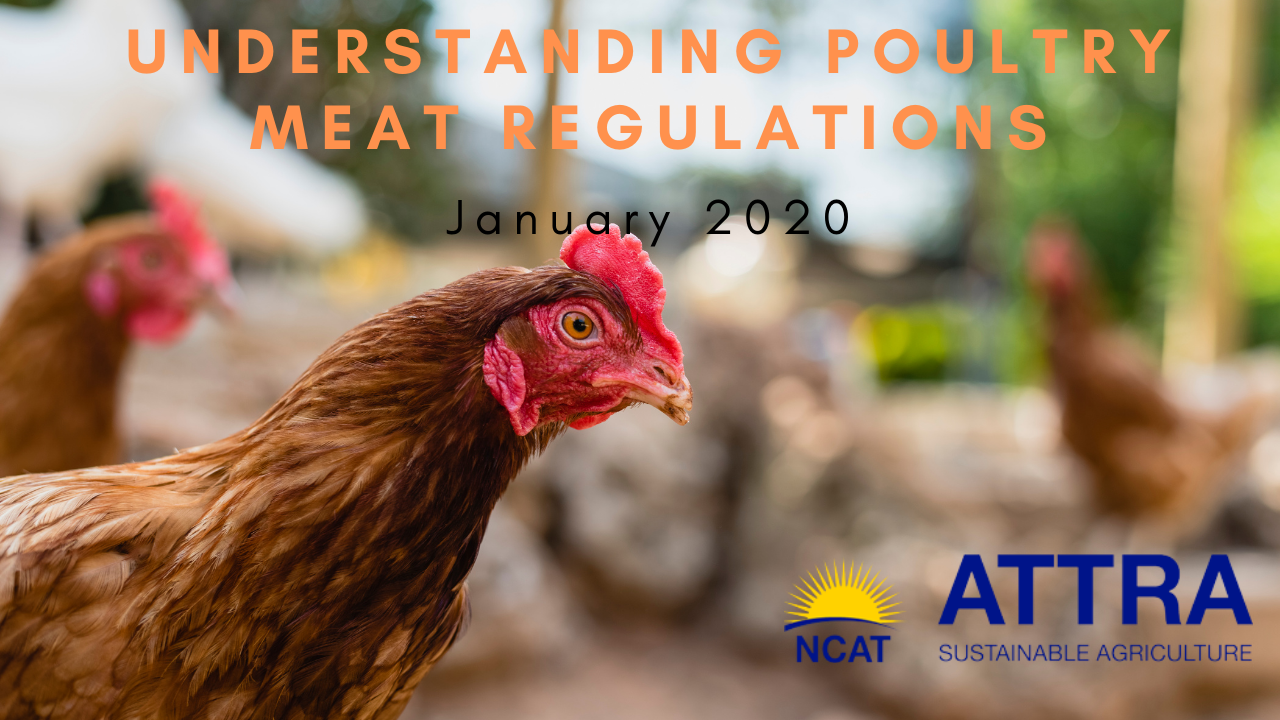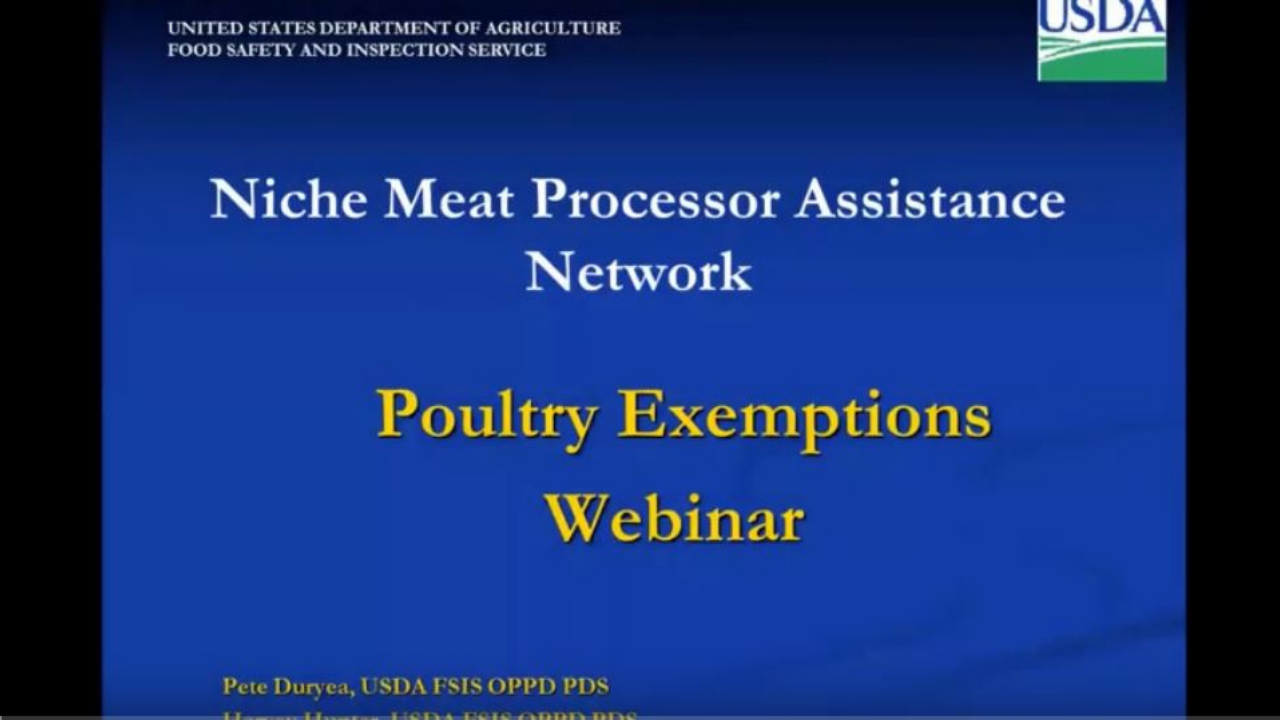On-farm Poultry Meat Processing with USDA Exemption
On this page:
- Overview of USDA Exempt Processing
- Definitions & General Information
- USDA Exempt, CDFA Exempt Facilities
- USDA exempt, CDFA Licensed Facilities
- Tables:
- Label Requirements for Exempt Processed
- USDA/CDFA Exempt
- USDA Exempt/CDFA Licensed
- Resources:
- Sanitation
- Mobile Processing
- USDA
- On-Farm Processing in Marin County
See also:
- Additional Meat Processing Resources for processing studies, marketing ideas, processing plants and poultry specific information
- On-Farm Poultry Processing by UCCE Marin, specifically Business Model
- Plant in a Box for poultry processing
- Selling Locally Grown Meat general overview of regulations that apply to all meat
- Selling Meat at Farmers Market
Overview of USDA Exempt Processing
The USDA carved out an exemption for small-scale on-farm poultry producers to not require that the poultry be harvested and processed at a USDA inspected facility; the so-called 'poultry exemption.' There are a variety of exemption types, only those most likely applicable to Sonoma County producers are covered here.
‘USDA exempt poultry processing’ does not mean exempt from all the requirements of the Poultry Products Inspection Act; it does mean the poultry operation is exempt from bird-by-bird inspection and the presence of USDA Food Safety Inspection Services (FSIS) inspectors during the slaughter and processing of poultry.
Have a question?
Ask the Ag Ombudsman

Meat processed at a USDA inspected facility allows for the greatest market potential, but because there is not a USDA inspected facility for small-scale producers in the North Bay (closest being Sacramento and Stockton), many small-scale poultry meat producers use the 'poultry exemption.' See Additional Meat Resources for Processing Information.
In Sonoma County: processing meat for sale on non-commercially zoned parcels requires a use permit, and probably building, electrical and plumbing permits from Permit Sonoma .
Definitions and General Information
- Acronyms:
- CDFA - California Department of Food & Agriculture
- MPES - Meat, Poultry & Egg Safety branch of CDFA
- USDA - United States Department of Agriculture
- FSIS - Food Safety Inspection Services branch of USDA
- CDFA - California Department of Food & Agriculture
- Poultry includes: turkeys, chickens, ducks, geese, squab, guinea fowl and ratites (emus, rhea and ostrich) and small game birds such as quail, pheasant and partridge.
- Rabbits are a non-amenable (exotic) species to USDA FSIS. However, CDFA considers rabbits in the same class as poultry.
Rabbit operations can operate under the CDFA exemption without limitation to the number of rabbits processed per year. - Rabbit facilities can become CDFA licensed if they want to increase their marketing opportunities and/or process rabbits raised by others.
- Operations can only process under one USDA exemption type.
- Operations must keep records of their sales to prove they have not violated their exemption.
- Operations may choose to become licensed with CDFA.
- Meat storage lockers must be registered with USDA FSIS Meat & Poultry Handler 5020-1 when selling to third parties (not required if only selling direct to consumer).
- On-farm poultry processing facilities have the option to be:
- USDA Exempt, CDFA Exempt - allows for sale direct to consumer only
- USDA Exempt, CDFA Licensed - allows for more sales options
USDA Exempt, CDFA Exempt Facilities
Requirements and restrictions for these operations are:
- Poultry (and rabbits) must be sold direct to consumer only (no wholesale/sold to be resold)
- Poultry (and rabbits) must be raised and slaughtered on site (cannot purchase/process poultry or rabbits raised by others)
- See Table 2: USDA Exempt, CDFA Exempt (below)
- The following restrictions apply (for poultry and rabbits)
- If no employees are used (processed only by immediate family members), the meat can be sold on or off the farm (i.e. farmers market). California Food and Agriculture Code section 24713.
- If employees are used, the meat can only be sold on the farm. California Food and Agriculture Code section 24714.
Up to 1,000 poultry processed per year and CDFA exempt:
- These operations do not need to register with CDFA MPES.
- No limit to the number of rabbits processed under the CDFA exemption.
Over 1,000 poultry processed per year:
- These operations must register with CDFA MPES. (CDFA Exempt Rabbit operations need not register).
- CDFA reviews these operations once a year at minimum and up to four times a year, USDA FSIS conducts annual reviews of selected operations.
- CDFA is contracted with USDA to make sure exempt poultry operations processing 1,000 or more poultry per year are complying with the USDA requirements.
When processing over 1,000 birds a year, CDFA Ensures:- Treatment of offal (inedible) – either with a rendering company (CDFA issued Inedible Permit required) or correctly composted on-site.
- Registration with Water Quality Control Board for processing and on-site composting as applicable
- Water quality is acceptable (private wells to be tested every 6 months)
- Water of sufficient quantity, temperature and pressure needed for cleaning
- Building meets processing standards required – kill area must be protected from environmental influence.
- Proper Labeling
- Adequate sewage and wastewater disposal system: The facility must maintain records from the state or local health agency or septic company documenting adequate sewage systems.
USDA Exempt, CDFA Licensed Facilities
Additional requirements for CDFA Licensed facilities:
- Maximum of 20,000 poultry (as defined above) processed per year. No limit for rabbits.
- Fulfill CDFA requirements to obtain Poultry Inspection license
- At least one Poultry Meat Inspector (PMI) on site at all times while processing
- Poultry processed under PMI supervision receive a CDFA Mark of Inspection
- Written Sanitation Standard Operating Procedure (SSOP) is required
- Cost: $100 for application; $500 for poultry plant License and $100 for PMI annually. Cost goes up for operations processing more than 15,000 poultry annually.
See Table 3: USDA Exempt, CDFA Licensed (below)
Specific USDA Exemption Types Defined
USDA Exemption types most likely to be used in Sonoma County include:
- Producer Grower – raise, slaughter and process*
- Producer Grower or Other Person – raise, slaughter and process*; purchases live birds raised by others and slaughter and process*
- Small Enterprise – raise, slaughter and cut-up poultry; purchase live poultry to slaughter and cut-up; purchase cut-up Federal or State inspected poultry which it distributes. Another grower can sell their birds to a “Small Enterprise” processor who slaughters, prepares and packages the birds (whole and/or cut-up only) for retail purchase and then the grower can purchase the birds back, acting as a distributor, for sale.
*for approved processing activities see tables 2 and 3.
Tables
Table 1 outlines the labeling requirements.
Table 2 compares criteria for USDA exempt facilities without CDFA license.
Table 3 compares criteria for USDA exempt facilities with CDFA license.
Table 1: Label Requirements for Exempt Processed Poultry
NOTE: These requirements also apply to CDFA licensed rabbit operations. If the rabbit operation is CDFA exempt (not CDFA licensed), there are no labeling requirements.
NOTE: “No” indicates the criteria is not required, however, producers can choose to include it on their label.
|
Criteria |
Producer Grower |
Producer Grower |
Small Enterprise |
|
|
Name of Product |
No |
No |
Yes |
|
|
Ingredients |
No |
No |
Yes |
|
|
Statement of Quantity/Weight |
No |
No |
Yes |
|
|
Name & Address of Manufacturer/Processor |
Yes |
Yes |
Yes |
|
|
Date of Packing |
No |
No |
Yes |
|
|
Statement: |
Yes |
Yes |
Yes |
|
|
Safe Handling Instructions |
Yes |
Yes |
Yes |
|
|
CDFA Licensed Facilities only: |
||||
|
CDFA mark of inspection |
Yes |
Yes |
Yes |
|
Table 2: USDA Exempt, CDFA Exempt
Note: Limitations due to California Retail Food Code – “Approved Source” food products must be processed while under inspection otherwise the food product may only be sold direct from the farmer to the consumer and can only be used for personal use (cannot be made into food products to be consumed by the public).
|
Criteria |
Producer Grower 1,000 Limit |
Producer Grower 20,000 Limit |
Producer Grower or Other Person |
Small Enterprise |
|
CDFA Registration Required |
No |
Yes |
Yes |
Yes |
|
Annual Slaughter Limit |
1,000 |
20,000 |
20,000 |
20,000 |
|
Can Process others poultry |
No |
No |
No |
No |
|
Sell direct to consumer[i] |
Yes |
Yes |
Yes |
Yes |
|
Sell to HRI[ii] |
No |
No |
No |
No |
|
Sell to Distributor |
No |
No |
No |
No |
|
Sell to Retail Store |
No |
No |
No |
No |
|
Process meat[iii] |
Yes |
Yes |
Yes |
Cut-up only[iv] |
[i] Direct to consumer sales allowed off-farm (i.e. farm mkt, community event, etc) if processed only by immediate family members (see USDA Exempt, CDFA Exempt section above)
[ii]HRI: Hotel, Restaurant, Institution
[iii] Per CA Food & Ag Code 25411 “Processing” means the commercial manufacturing of products of poultry meat by any method of cooking. It also includes all of the following: (a) Cutting up into pieces smaller than the customary parts such as, in the case of poultry, necks, breasts, wings, backs, legs, thighs, or similar and identifiable portions of the carcass. (b) Complete deboning of poultry meat. Including: cut-up, grind, marinate, flavor and cook.
Not allowed: cure, smoke, can, repack, and so on; those processes must be done at a CDFA licensed or USDA inspected facility (canning only at USDA facility).
[iv] Small Enterprise processing activity is limited to cut-up only.
Table 3: USDA Exempt, CDFA License
Note: Poultry and rabbit processed in a state licensed facility is considered “Approved Source” because the Poultry Meat Inspector (PMI) is present during all activities and the meat is stamped with CDFA mark of inspection.
|
Criteria |
Producer Grower |
Producer Grower or |
Small Enterprise |
|
CDFA Registration Required |
Yes |
Yes |
Yes |
|
CDFA Licensed, PMI required |
Yes |
Yes |
Yes |
|
Annual Slaughter Limit |
20,000 |
20,000 |
20,000 |
|
Can process others poultry |
No |
No |
Yes[i] |
|
Sell direct to consumer |
Yes |
Yes |
Yes |
|
Sell to HRI[ii] |
Yes |
Hotels, Restaurants & |
Yes |
|
Sell to Distributor |
Yes |
Yes[iii] |
Yes |
|
Sell to Retail Store |
Yes |
No |
Yes |
|
Process meat[iv] |
Yes |
Yes |
Cut-up only[v] |
[i] Must purchase poultry prior to processing.
[ii]HRI: Hotel, Restaurant, Institution.
[iii] Distributor can deliver meat only to allowed entities.
[iv] Per CA Food & Ag Code 25411 “Processing” means the commercial manufacturing of products of poultry meat by any method of cooking. It also includes all of the following: (a) Cutting up into pieces smaller than the customary parts such as, in the case of poultry, necks, breasts, wings, backs, legs, thighs, or similar and identifiable portions of the carcass. (b) Complete deboning of poultry meat. Including: cut-up, grind, marinate, flavor and cook. Including: cut-up, grind, marinate, flavor, cook, cure, smoke, repack, and so on.
Not allowed: canning; canning must be done at a USDA inspected facility.
[v] Small Enterprise processing activity is limited to cut-up only.
Resources
Best-Practices Guide to Open-Air Poultry Slaughter written for Oregon. Practices are applicable here.
Best Practices in On-Farm Poultry Processing video by Dirigo Food Safety.
CDFA guidance for exempt poultry processing, provided by CAFF.
CDFA Training Manual for Poultry Meat Inspector to assist the applicant to become licensed and to operate effectively as a Processing Inspector.
Exempt Poultry Questions from CDFA to USDA
Poultry Specific Resources at NMPAN includes design and costs to build USDA plant, case studies, business plans, processing best practices, food safety research, producer resources and much more!
Small-Scale Poultry Processing guide also covers equipment needs, waste product management, and packaging needed to get poultry meat to market by ATTRA Sustainable Ag. Note: this guide does not address specific state and local requirements.
Sanitation:
- Chlorine Dilution Calculator - for solutions to clean surfaces as well as product
- USDA: Controlling Salmonella in Poultry Plants
- Chlorine in poultry processing
- Chlorine as sanitizer
- Birko Chicxide - lactic/citric acid spray for carcasses used prior to packaging
Mobile Processing:
- Nevada County Grown MPU rental
- Plant in a Box
USDA:
- USDA Ask FSIS – answers to USDA meat-related questions
- USDA Small Plant Help Desk – get answers regarding small-scale meat processing
On-Farm Processing in Marin County:
Note: We are working on similar guidance for Sonoma County.
Collaboration and Reference
This fact sheet was reviewed for accuracy by the Supervising Meat Inspector of CDFA Meat Poultry & Egg Safety division, October 2016.
USDA FSIS Guidance for Determining whether a Poultry Slaughter or Processing Operation is Exempt from Inspection Requirements of the Poultry Products Inspection Act, Revision 1, April 2006
CDFA guidance for exempt poultry processing, provided by CAFF.
CDFA Training Manual


